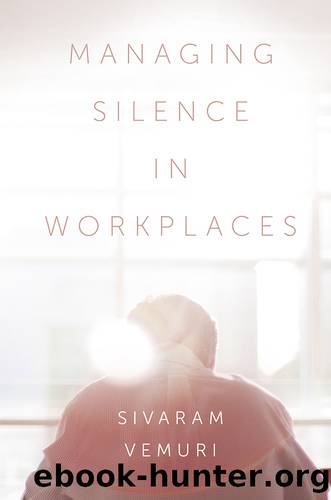Managing Silence in Workplaces by Vemuri Sivaram;

Author:Vemuri, Sivaram;
Language: eng
Format: epub
Publisher: Emerald Publishing Limited
Published: 2019-06-04T00:00:00+00:00
Impression Formation
How managers and employees form impressions about each other and situations they meet has been examined at length by social psychologists. A number of these suggest that Gestaltâs ideas and principals play a central role in the formation of judgement about a specific situation:
Aschâs impression formation work (Asch 1946; Asch & Zukier, 1984) argued that the processing of social stimuli was holistic. Heider (1958) relied heavily on Gestalt principles of structure and organization (e.g. good form and equilibrium) in his classic work on attribution theory and causal perception. Lewinâs (1947a, 1947b) model of group process and other early work on groups viewed group membersâ social interactions in terms of interacting fields of forces; group properties (e.g. group cohesiveness) were the result of interacting force fields (Festingerâs (1950). And consider Heiderâs (1946, 1958) balance theory and Festingerâs (1957) theory of cognitive dissonances. In discussing belief systems and their consistency, both relied heavily on Gestalt ideas of structural dynamics and Gestalt principles of organization and structure, such as good form and equilibrium. (Read et al., 1997, pp. 26â27)
All these studies help to explain how the form and manner of interactions among members of organisations lead to impressions formed by the people in those organisations. âGestalt psychologists proposed that our perceptions of the world are guided by organizational principles such as good form, proximity, and similarityâ. (Read et al., 1997, p. 36). This is one reason why interactions and silence among people are complex and complicated to measure, since individuals interpret their actions by superimposing subjectivity and infer causality based on arrangements of the events encountered. They juxtapose perceptions of reality and imagination and form their mental models based on similarity to previous experiences.
To manage silence in an ethical manner, it is necessary to escape subjective judgement of the other but at the same time build on their individual interpretation of themselves. This poses another complexity because the experiences for understanding individual actions are likely to be the same before, during and after interactions occur.
There is a change in focus when one is deciding and interpreting the decision made based on hindsight. A frame of reference is superimposed that did not exist when a decision was being taken.
The framework for understanding individual actions is likely not to be the same as before because the interactions that occur about a specific issue between employees in an organisation during and after a decision has been made dictate how the past decision is interpreted. Learning takes place when actions are implemented. Adjustments occur. There is ambiguity of the outcomes before actions are contemplated. For example, strategies are proposed for changes to take place in work contexts. Some agree and others disagree with the proposal, but when the change management strategy is implemented, the intended outcomes may not be realised and this will call for adjustments to be made. The same individuals as decision-making architects will respond differently when decisions are implemented because while implementing there is clarity about what was the earlier ambiguity. As a
Download
This site does not store any files on its server. We only index and link to content provided by other sites. Please contact the content providers to delete copyright contents if any and email us, we'll remove relevant links or contents immediately.
Time Management Made Easy: How to Cultivate New Habits, Improve Productivity and Get Things Done by Joshua Strachan(2364)
The 7 Habits of Highly Effective People by Stephen R. Covey & Sean Covey(2095)
The Concise Laws of Human Nature by Robert Greene(1712)
Doesn't Hurt to Ask by Trey Gowdy(1555)
Primal Leadership by Daniel Goleman(1123)
Hook Point: How to Stand Out in a 3-Second World by Brendan Kane(1098)
HBR's 10 Must Reads 2021 by unknow(1044)
Don't Sweat the Small Stuff...and It's All Small Stuff by Richard Carlson(1012)
Amazon Unbound by Brad Stone(979)
100 Things Successful People Do by Nigel Cumberland(963)
HBR's 10 Must Reads 2021 by Harvard Business Review(955)
The Job Closer by Steve Dalton(935)
Master of One by Jordan Raynor(934)
Lives of the Stoics by Ryan Holiday & Stephen Hanselman(899)
Declutter Your Mind: A step by step guide to learn to control your thoughts, stop worrying, relieve anxiety and eliminate panic attacks and negative thinking by Mia Chandler(875)
The Power of 100! by Shaun King(841)
Conflicted by Ian Leslie(798)
Coders at Work: Reflections on the craft of programming by Peter Seibel(787)
The Book of Hope by Jane Goodall(743)
